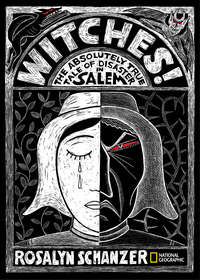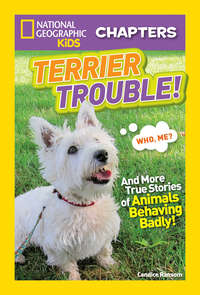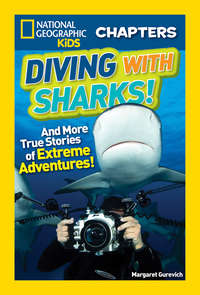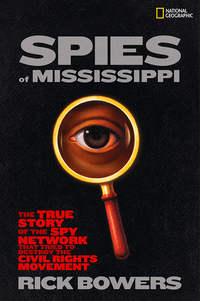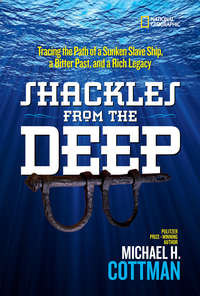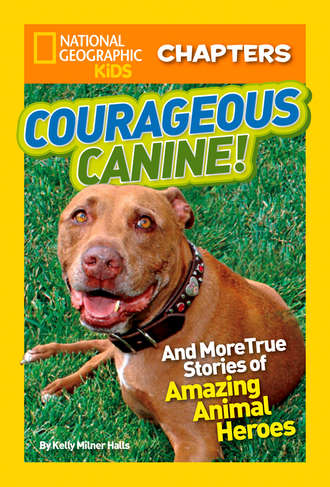
Полная версия
National Geographic Kids Chapters: Courageous Canine: And More True Stories of Amazing Animal Heroes

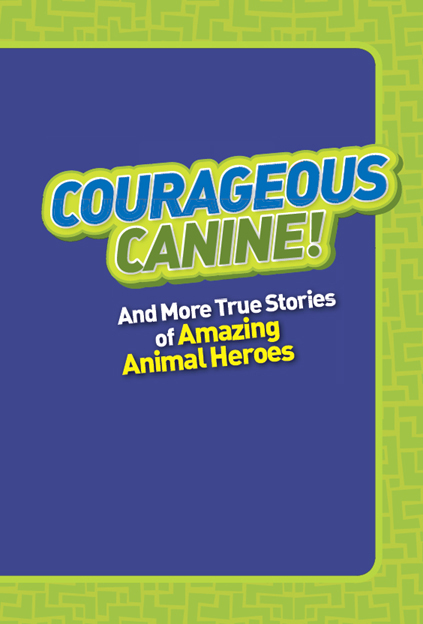
Copyright © 2013 National Geographic Society
All rights reserved. Reproduction of the whole or any part of the contents without written permission from the publisher is prohibited.
Published by the National Geographic Society
John M. Fahey, Chairman of the Board and Chief Executive Officer
Declan Moore, Executive Vice President; President, Publishing and Travel
Melina Gerosa Bellows, Executive Vice President; Chief Creative Officer, Books, Kids, and Family
Prepared by the Book Division
Hector Sierra, Senior Vice President and General Manager
Nancy Laties Feresten, Senior Vice President, Kids Publishing and Media
Jay Sumner, Director of Photography, Children’s Publishing
Jennifer Emmett, Vice President, Editorial Director, Children’s Books
Eva Absher-Schantz, Design Director, Kids Publishing and Media
R. Gary Colbert, Production Director
Jennifer A. Thornton, Director of Managing Editorial
Staff for This Book
Marfé Ferguson Delano, Project Editor
Becky Baines, Editor
Lisa Jewell, Illustrations Editor
David Seager, Art Director
Ruthie Thompson, Designer
Grace Hill and Michael O’Connor, Associate Managing Editors
Joan Gossett, Production Editor
Lewis R. Bassford, Production Manager
Susan Borke, Legal and Business Affairs
Ariane Szu-Tu, Editorial Assistant
Callie Broaddus, Design Production Assistant
Hillary Moloney, Illustrations Assistant
Manufacturing and Quality Management
Phillip L. Schlosser, Senior Vice President
Chris Brown, Vice President, NG Book Manufacturing
George Bounelis, Vice President, Production Services
Nicole Elliott, Manager
Rachel Faulise, Manager
Robert L. Barr, Manager

The National Geographic Society is one of the world’s largest nonprofit scientific and educational organizations. Founded in 1888 to “increase and diffuse geographic knowledge,” the Society’s mission is to inspire people to care about the planet. It reaches more than 400 million people worldwide each month through its official journal, National Geographic, and other magazines; National Geographic Channel; television documentaries; music; radio; films; books; DVDs; maps; exhibitions; live events; school publishing programs; interactive media; and merchandise. National Geographic has funded more than 10,000 scientific research, conservation, and exploration projects and supports an education program promoting geographic literacy.
For more information, please visit
www.nationalgeographic.com, call 1-800-NGS LINE (647-5463), or write to the following address: National Geographic Society 1145 17th Street N.W. Washington, D.C. 20036-4688 U.S.A.
Visit us online at
www.nationalgeographic.com/books
For librarians and teachers:
www.ngchildrensbooks.org
More for kids from National Geographic:
kids.nationalgeographic.com
For rights or permissions inquiries,
please contact National Geographic Books
Subsidiary Rights: ngbookrights@ngs.org
eISBN: 978-1-4263-1398-1
v3.1
Version: 2017-07-10
CONTENTS
Cover
Title Page
Copyright
LILLY: Courageous Canine
Chapter 1: Love at First Sight
Chapter 2: Lilly to the Rescue
Chapter 3: A New Career
DOLPHINS: Daring Rescuers
Chapter 1: Shark Attack!
Chapter 2: A Pod of Protectors
Chapter 3: Life Savers
BINTI JUA AND JAMBO: Gorilla Good Guys
Chapter 1: Boy Meets Gorilla
Chapter 2: Bringing Up Binti
Chapter 3: Another Great Ape
DON’T MISS!
More Information
Dedication
Credits
Acknowledgments
LILLY: COURAGEOUS CANINE
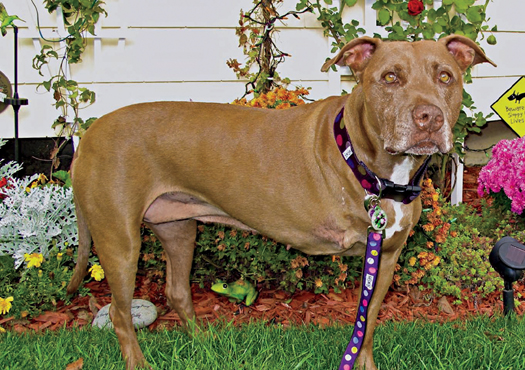
Lilly stands strong on her three legs. Her beautiful golden eyes seem to shine with courage. (photo credits p1.1)
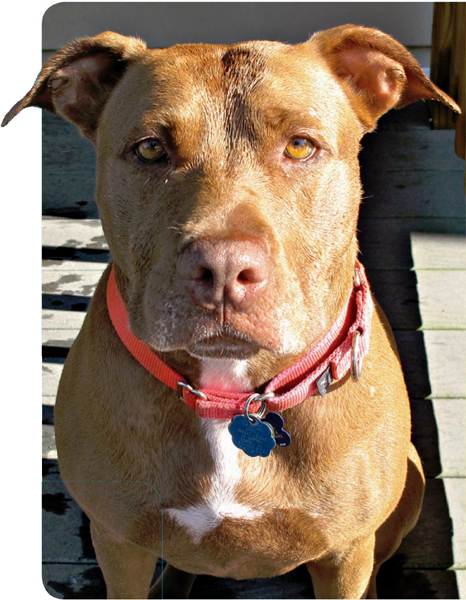
Lilly the pit bull is gentle and sweet. She loves to be scratched under her ears. (photo credits p1.2)
Chapter 1
LOVE at First Sight
For Lilly, it started as an ordinary day. The five-year-old dog paced across her cage at the Animal Rescue League (sounds like LEEG) in Boston, Massachusetts. She ate her breakfast kibble. She curled up on her blanket to take short naps. Once in a while, she even barked with the other dogs. But she mostly seemed sad and lonely. Like the rest of the animals at the shelter, she needed a home.
That March morning in 2009 started out as a regular day for David Lanteigne (sounds like LAN-tane), too. But he was excited. He was going to do something new later that day. Something awesome. He was going to volunteer at the Animal Rescue League (ARL).

David is a police officer in Boston. He works five days a week helping people. On his day off, he wanted to help homeless dogs. At the shelter, David filled out the forms to become a volunteer. Then he asked if he could meet the canines (sounds like KAY-nines). He meant the dogs. Dogs belong to the group of animals called canines.
“Sure,” the ARL workers said. “Come this way.”
Slowly, David strolled past the cages. He felt good about the job he had signed up to do. All of the dogs needed loving care, and he was just the guy to deliver it. Then, six cages in, his heart skipped a beat. He was face-to-face with Lilly.
“Hello, sweet girl,” he said. Lilly’s golden eyes met his. “You have the most beautiful eyes in the world,” David told her.
Lilly calmly walked to the edge of her cage where David waited. He gazed into her gentle eyes. Then he noticed deep scars on the dog’s left side. There were scars on the top of her head, too. Lilly has been mistreated, David thought. What kind of person could hurt such a warm-hearted dog?
Lilly pressed her soft brown body against her cage to get closer to David. He felt like she was telling him, I have been hurt, but I still know how to be good.
David sat down beside the cage to talk to Lilly. “You are a good girl,” he whispered. He stroked her fur through the cage. She liked it when he scratched her under her chin and behind her floppy ears. Her personality sparkled like a diamond.
“Can I walk one of the dogs?” David asked an ARL worker. “I think Lilly would like to go outside.”
Lilly loved walking with David. They galloped through the grass and down the streets. She gave David dozens of sloppy licks. For man and dog, it was love at first sight. David realized he didn’t just want to walk Lilly. He wanted to take her home.
To adopt Lilly, David needed to know if another dog and another person would love her, too. He had to introduce her to his dog, Penny. She’s a golden retriever (sounds like ree-TREE-ver). David also wanted Lilly to meet his mom, Christine. David hoped Christine would share Lilly with him. He knew his mom got sad and lonely at times. He hoped taking care of Lilly would make her feel happier.
David drove to his mother’s house. She lived about an hour away, in Shirley, Massachusetts. David told her about Lilly. “Just meet her,” he said. “Then you can decide if you like her as much as I do.” Christine agreed to go meet Lilly.
Like David, Christine thought Lilly was beautiful. She was a little scared about walking her, though. Lilly is an American pit bull terrier (sounds like TER-ee-er), or pit bull for short. She weighs 70 pounds (32 kg). When she tugged at the leash, Christine could feel how strong she was. But Lilly seemed to understand Christine’s fear. She quickly settled down.
Before they took Lilly back inside the shelter, David went to his car. Penny’s dog biscuits were in the trunk. He wanted to share them with Lilly. When he popped the trunk open, Lilly jumped inside. She was ready to go home!
What are pit bulls?
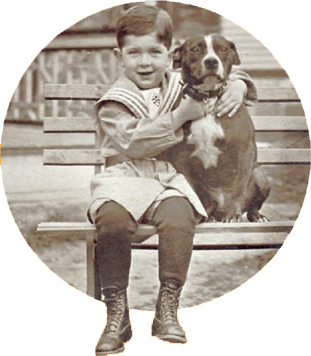
(photo credits 1.1)
The first pit bulls were probably a cross between two kinds of dogs: the English bulldog and the Old English terrier. People in England created the breed about 200 years ago. The dogs were strong, smart, and loyal. They made excellent hunting and watch dogs. In America, farmers used pit bulls to help protect cattle and sheep from wild animals. In the early 1900s, some pit bulls even looked after children. This earned them a special nickname. They were called “nanny dogs.”
A few days later, David took Penny to the shelter to meet Lilly. The two dogs got along very well. “That was it,” David says. “No matter what, I knew we were adopting Lilly.”
David and his mom shared Lilly, but the dog spent most of her time at Christine’s house in Shirley. Some people told Christine she should be afraid of keeping a pit bull in her home. They thought all pit bulls were dangerous. They thought the dogs liked to attack people. Christine didn’t listen to them. She trusted her son.
David knew the dogs weren’t born bad. But some cruel owners force their pit bulls to fight other dogs. These fights are against the law. Sometimes the dogs are badly hurt. Sometimes it’s even worse. All of this made David sad.
Being forced to fight can make an animal mean, but kindness can sometimes make it better. Christine believed David when he said Lilly was a loving dog, and he was right. Lilly kept her company when she got lonely. In return, Christine cooked Lilly yummy meals. They went on lots of walks together. Lilly made many new friends as she and Christine walked through town.
Thanks to David and Christine, Lilly had a safe place to live. She had plenty of good food to eat. Best of all, she got lots and lots of love. David and his mom had given her a second chance at life. One day Lilly would return the favor.
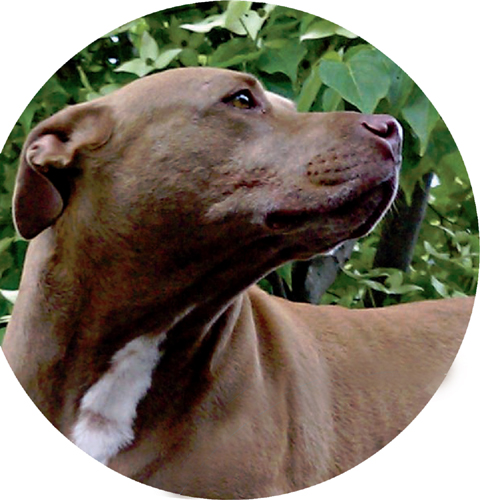
(photo credits 1.2)
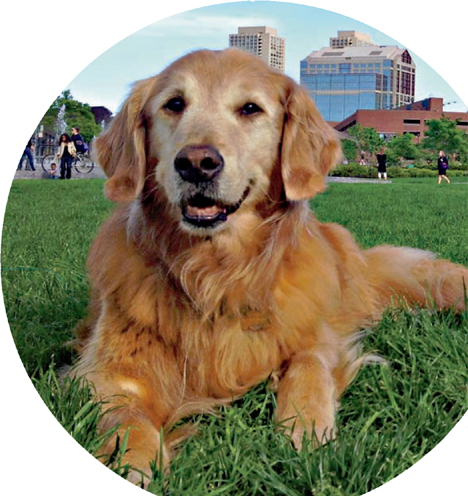
Lilly (top) and Penny (bottom) both like to hang out at the park. They’ve been friends ever since they met. (photo credits 1.3)
Chapter 2
LILLY to the RESCUE
Lilly the gentle pit bull and Christine lived a happy life together. David and Penny visited often to play. Sometimes Lilly and Christine went to Boston to see them. The police officer was proud of how his mother cared for Lilly. Then in May 2012, disaster struck.
One night Christine had trouble getting to sleep. So she decided to take Lilly for a late-night stroll. Together, they walked across the railroad tracks near their home.
They had crossed the tracks a thousand times before. But something went wrong that night. Christine suddenly felt dizzy. Lilly stood by her as she wobbled and fell. Then Christine blacked out. She didn’t see the bright light shining in the distance, but Lilly did. A freight train was rocketing their way.
The daring dog sprang into action. Lilly barked an urgent warning. Christine did not wake up. Lilly nipped and snapped at her owner’s arms and legs. Still nothing, as danger thundered on. Frantic, Lilly began to tug at Christine’s clothes. The train drew closer and closer.
Finally, the train engineer saw the dog and woman on the tracks. He tried to stop the heavy train, but it was going too fast. In the nick of time, Lilly dragged Christine off the tracks. Then the dog wrapped her body around the woman. The train hurtled by. The engineer felt a thump.
When the train rolled to a stop, he jumped to the ground. In a panic, he ran back to Lilly and Christine. He knew the train had hit something. “I thought they were dead,” he later said. They were not. In fact, Christine didn’t have a scratch on her. Lilly was not so lucky.
The engineer called for help. He looked down at the heroic pit bull. Her front right leg was covered in blood. It was badly hurt. She seemed unable to stand. But her golden eyes shined with courage. To his amazement, she was alert and friendly. She was also determined to stay close to Christine.
Police officers, firefighters, and paramedics (sounds like pare-uh-MED-iks) rushed to the scene of the accident. They phoned David. They told him his mother was all right, but Lilly was hurt. David had just started his evening shift in Boston. His boss knew how much he loved Lilly, though. “Go!” he told him. In a flash, David was on his way.

The paramedics wrapped Lilly’s injured leg in bandages. They tried to calm her. Many wounded dogs try to bite people who come near them. Lilly did not. So the paramedics petted and comforted her. They spoke to her softly. “It will be okay, girl,” they said. “Help is on the way.”
Animal control officers soon arrived to help Lilly. They wrapped her in a blanket and drove her to an emergency clinic for pets. But Lilly’s wounds were too serious for the clinic staff to fix. The train had nearly torn her right paw off. It was very, very bad. All the clinic doctors could do was wait for David. They knew he would have some hard choices to make.
When David pulled up to the animal clinic, he was afraid. He knew his mother was safe. But how badly hurt was Lilly? Would anyone be able to help her? Would she survive? Tears filled his eyes, just thinking about it. He blinked them away. He needed to focus on helping his dog.
“What should I do?” David asked the clinic doctors. But Lilly was the one that answered. When she heard David’s voice, she turned to look at him. She softly wagged her tail. Lilly wasn’t giving up. So David wouldn’t either.
“I saw the same beautiful eyes I saw when I adopted her,” David says. “I felt the same bond.”
The clinic doctors suggested David take Lilly to Angell (sounds like ANE-juhl) Animal Medical Center in Boston. They told him it was the best animal hospital in the state. If the doctors there couldn’t help Lilly, no one could.
Famous Pit Bulls
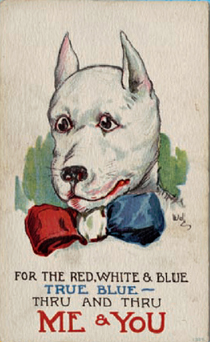
(photo credits 2.1)



Конец ознакомительного фрагмента.
Текст предоставлен ООО «ЛитРес».
Прочитайте эту книгу целиком, купив полную легальную версию на ЛитРес.
Безопасно оплатить книгу можно банковской картой Visa, MasterCard, Maestro, со счета мобильного телефона, с платежного терминала, в салоне МТС или Связной, через PayPal, WebMoney, Яндекс.Деньги, QIWI Кошелек, бонусными картами или другим удобным Вам способом.




